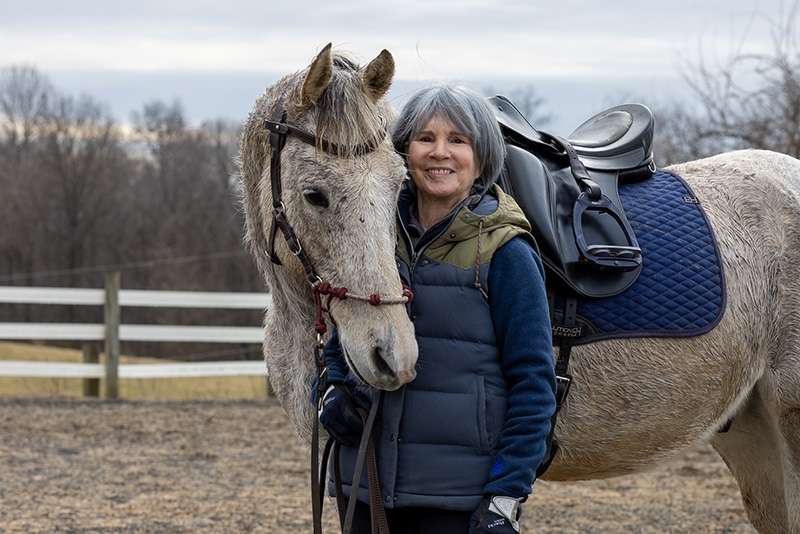Correcting roach back on a horse involves ensuring a proper saddle fit for back support and comfort. A well-fitted saddle pad can alleviate discomfort and prevent pressure points.
Roach back, also known as kyphosis, is a conformation issue where part of the spine curves upward instead of remaining straight. Horses with roach back may require special care to maintain their comfort and well-being. When dealing with a roach back condition, understanding the causes and appropriate treatment methods are crucial for the horse’s health and performance.
By addressing this issue effectively and providing the necessary support, horse owners can help their equine companions live a more comfortable and active life.

Understanding Roach Backed Horse
Causes Of Roach Back
Rapid growth in young horses leading to excessive flexion of the dorsal processes of the lumbar vertebrae is a common cause of roach back, also known as kyphosis.
Identifying Roach Back
Roach back is characterized by a hump-backed appearance in horses, distinguishable by unusually tall dorsal processes of the lumbar vertebrae.
Management And Treatment
- Ensure a correct saddle fit to alleviate discomfort and provide back support.
- Utilize a well-suited saddle pad and appropriately fitting saddle to address pressure points.
- Consult with a veterinarian for specialized management and treatment options.
Impact On Horse Riding
Roach Backed Horses and Their Impact on Horse Riding
Effect On Saddle Fit
Proper saddle fit is crucial for roach backed horses to prevent discomfort and ensure adequate back support. Utilizing a well-fitted saddle pad and saddle can help alleviate potential pressure points.
Health Implications
- Risk of musculoskeletal dysfunction
- Potential discomfort and pain
- Impact on overall horse well-being
Riding Techniques For Roach Backed Horses
- Focus on balanced riding to support the horse
- Implement gentle, controlled movements
- Engage in regular back strengthening exercises for the horse
Training And Conditioning
The training and conditioning of a roach-backed horse are crucial to ensure its well-being and performance. Addressing the specific needs and challenges presented by a roach-backed horse requires a tailored approach to exercises, movement, and posture. Effective training and conditioning are essential to improve the horse’s back muscles and overall physical condition.
Exercises To Improve Back Muscles
Exercising the back muscles of a roach-backed horse is vital for strengthening and supporting the affected area. Tailored exercises that focus on increasing flexibility and strengthening muscles can help improve the horse’s back condition.
Addressing Movement And Posture Issues
Improving movement and posture in roach-backed horses is fundamental for their well-being. Specific exercises and training aimed at enhancing the horse’s gait and promoting proper posture can greatly benefit their condition.

Buying And Owning A Roach Backed Horse
Owning a roach backed horse can be challenging, but with proper management and care, it can be a fulfilling experience. Ensure the saddle fit is suitable to alleviate discomfort, offer back support, and minimize pressure points. Regular veterinary check-ups and tailored exercise routines are essential for the well-being of these unique horses.
Considerations For Prospective Buyers
If you are considering buying a roach backed horse, there are a few important factors to keep in mind.
- Physical Fitness: Ensure that the horse is in good physical condition, with well-developed abdominal and back muscles. A horse with a strong physique will be better equipped to handle the weight and demands placed on their back.
- Saddle Fit: A correct saddle fit is paramount for horses experiencing roach back. It is important to choose a well-suited saddle pad and a saddle that provides proper support and avoids potential pressure points.
- Health History: Investigate the horse’s health history to identify any underlying issues that could affect their condition. Consult with a veterinarian to gain a comprehensive understanding of the horse’s health status.
- Training and Experience: Assess the horse’s training and experience level. Proper training and exercise routines can positively impact a horse’s back health, so ensure that they have received appropriate training and have a history of regular exercise.
Long-term Care And Management
Owning a roach backed horse requires careful long-term care and management. Here are some key considerations:
- Diet and Nutrition: Provide a balanced diet that meets the specific nutritional needs of the horse. Consult with a veterinarian or equine nutritionist to develop a suitable feeding plan.
- Regular Exercise: Engage the horse in regular exercise routines to strengthen their back muscles and overall fitness. Consult with a professional trainer to design an exercise regimen suitable for the horse’s condition.
- Veterinary Care: Schedule regular check-ups with a veterinarian to monitor the horse’s overall health and address any potential issues before they escalate.
- Saddle Maintenance: Regularly inspect and maintain the saddle to ensure it provides optimal support and comfort for the roach backed horse. Replace the saddle if necessary to maintain proper fit and minimize stress on the horse’s back.
Community Insights And Experience
A thriving community of horse owners and enthusiasts exists to share insights and experiences about the topic of roach-backed horses. This community offers valuable knowledge and support for those dealing with this condition. By actively participating in horse owner forums, seeking expert opinions, exploring case studies, and listening to success stories, individuals can gain a deeper understanding of roach-backed horses and discover effective strategies for managing this condition.
Horse Owner Forums
Horse owner forums provide unique opportunities to connect with fellow horse owners facing similar challenges related to roach-backed horses. These forums serve as virtual gathering places where individuals can ask questions, share experiences, and seek advice on various aspects of managing this condition.
In these forums, horse owners discuss topics such as saddle fit, exercise routines, dietary considerations, and overall care for roach-backed horses. By actively engaging in these conversations, individuals can benefit from the collective wisdom and experience of the community.
Expert Opinions
Seeking expert opinions is crucial when it comes to understanding the complex nature of roach-backed horses. Equine specialists, veterinarians, and trainers who have extensive experience working with these horses can provide valuable insights and guidance.
Experts can offer advice on saddle fitting, exercises to strengthen the back muscles, and potential treatments to alleviate discomfort. Their knowledge and expertise can empower horse owners to make informed decisions regarding the care and management of roach-backed horses.
Case Studies And Success Stories
Exploring real-life case studies and success stories can be incredibly inspiring and informative for individuals dealing with roach-backed horses. These stories capture the journeys of horse owners who have successfully managed and improved the condition of their horses.
Case studies provide detailed accounts of the strategies, treatments, and lifestyle adjustments that have proven effective in addressing roach backs. Success stories highlight the resilience and dedication of horse owners who have overcome the challenges associated with this condition.
By learning from these experiences, individuals can gain new perspectives and discover innovative approaches to enhance the well-being of roach-backed horses in their care.

Frequently Asked Questions On Roach Backed Horse
How Do You Fix Roach Back On A Horse?
To fix roach back on a horse, ensure proper saddle fit for back support and comfort. Use a well-fitted saddle pad to reduce pressure points.
What Does It Mean To Be Roach Backed?
A roach back in horses is a curvature of the spine that creates a hump appearance. It can be genetic or functional and affects saddle fit and back support.
What Is The Difference Between A Sway Back And A Roach Back?
A sway back has a dip in the spine, while a roach back has an upward curve.
Is Roach Back Genetic In Horses?
Roach back in horses can be genetic or caused by musculoskeletal dysfunction. It is a conformation issue where part of the spine curves upwards instead of staying straight. Saddle fit is crucial for these horses, and using a well-suited saddle pad and properly fitting saddle can help alleviate discomfort.
Conclusion
In addressing the challenges of roach back in horses, it’s crucial to prioritize saddle fit to alleviate discomfort and provide essential back support. Ensuring a well-suited saddle pad and a properly fitting saddle can effectively manage potential pressure points and promote the horse’s overall well-being.
Understanding and addressing this conformation issue can greatly enhance the horse’s quality of life.

